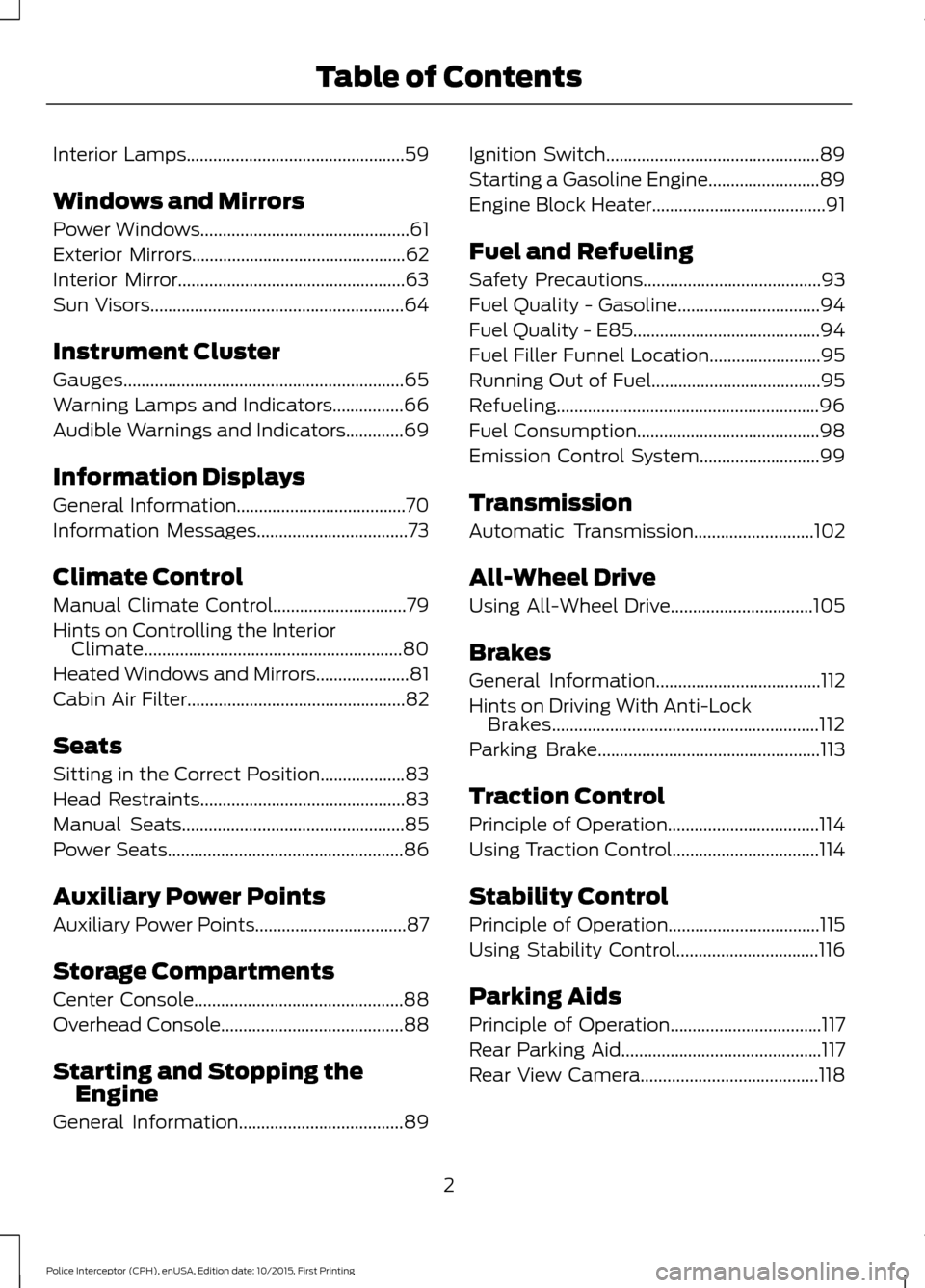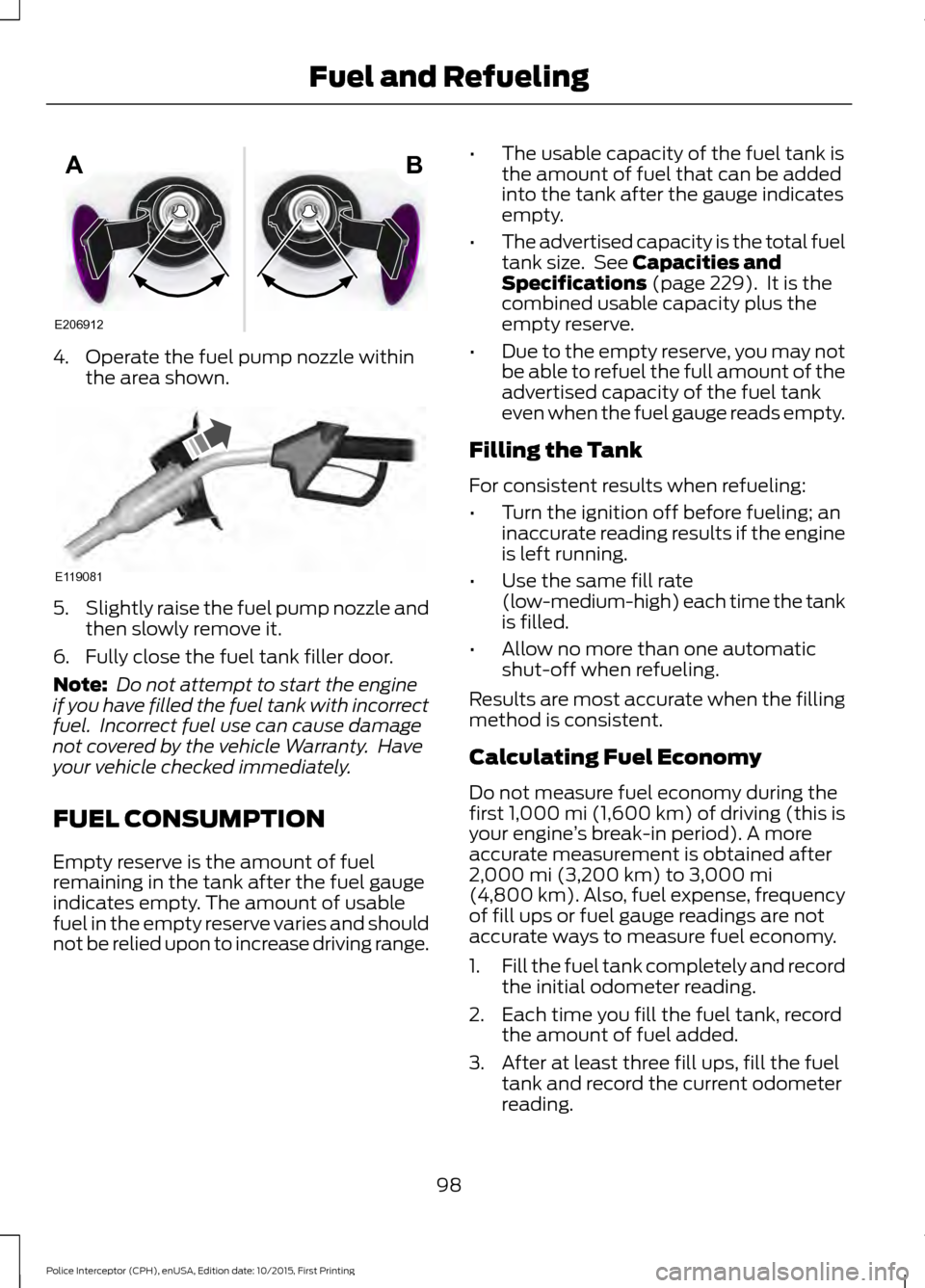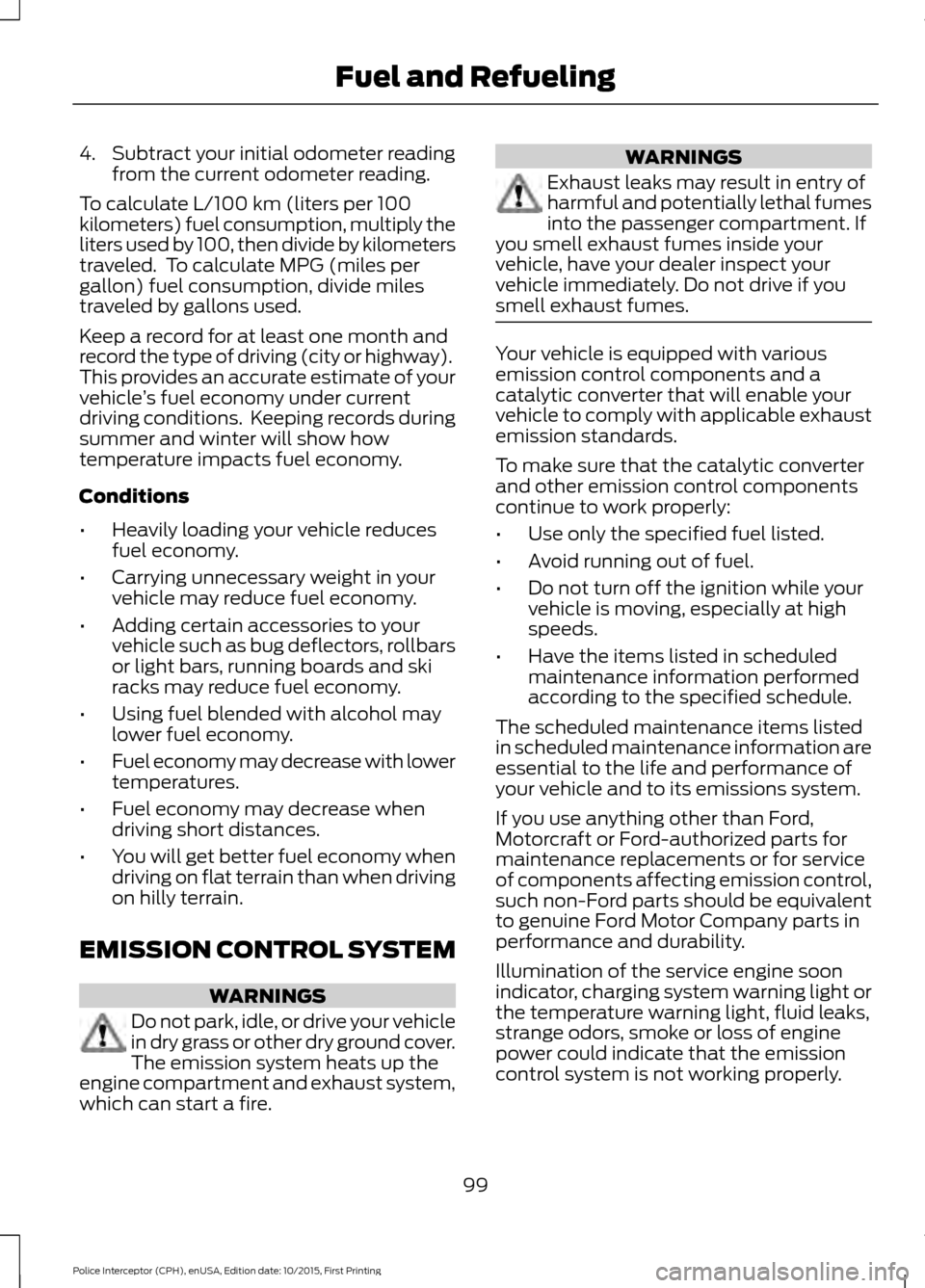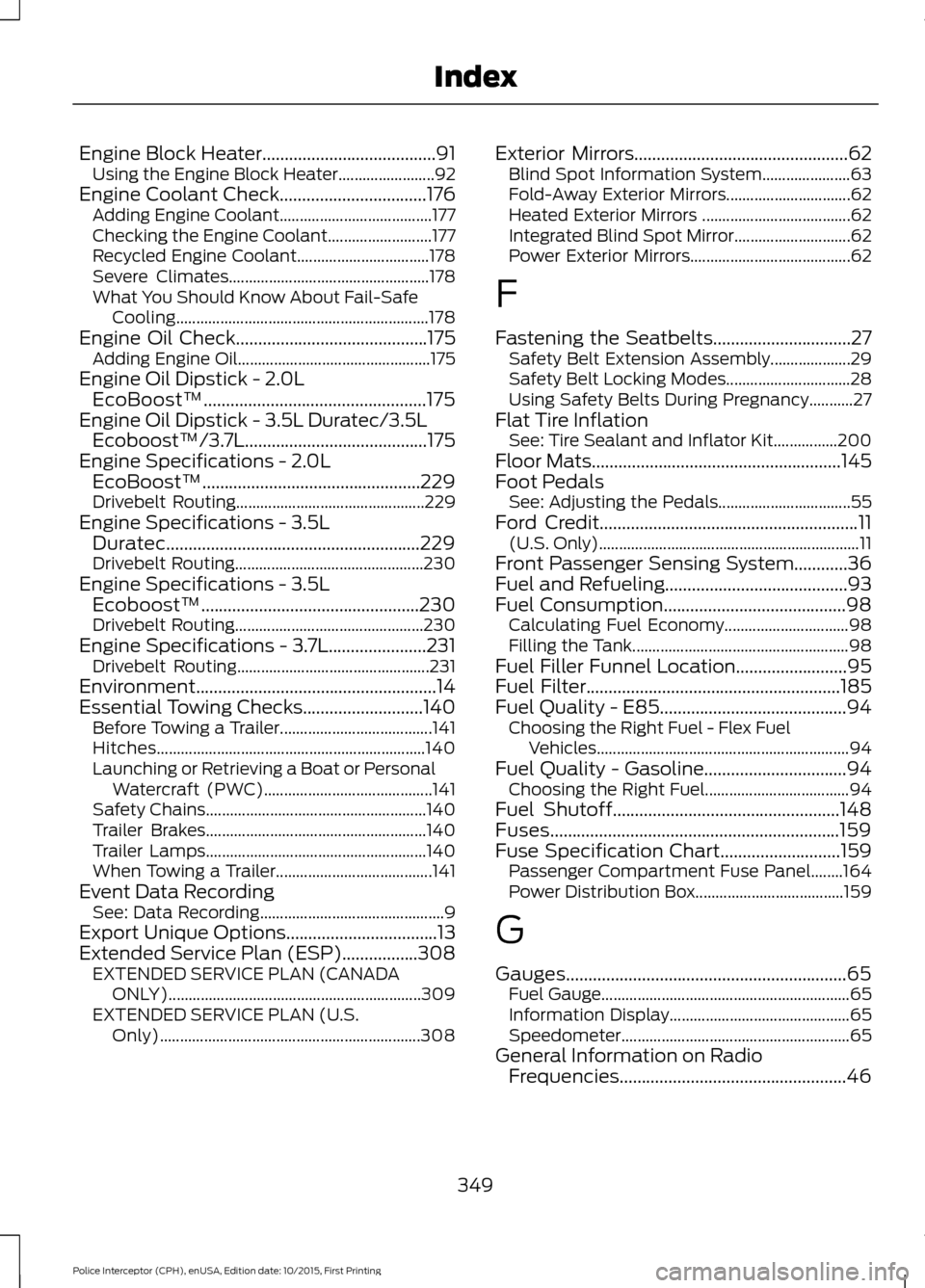fuel consumption FORD POLICE INTERCEPTOR SEDAN 2016 1.G Owners Manual
[x] Cancel search | Manufacturer: FORD, Model Year: 2016, Model line: POLICE INTERCEPTOR SEDAN, Model: FORD POLICE INTERCEPTOR SEDAN 2016 1.GPages: 358, PDF Size: 3.55 MB
Page 5 of 358

Interior Lamps.................................................59
Windows and Mirrors
Power Windows...............................................61
Exterior Mirrors................................................62
Interior Mirror...................................................63
Sun Visors.........................................................64
Instrument Cluster
Gauges
...............................................................65
Warning Lamps and Indicators................66
Audible Warnings and Indicators.............69
Information Displays
General Information......................................70
Information Messages
..................................73
Climate Control
Manual Climate Control
..............................79
Hints on Controlling the Interior Climate
..........................................................80
Heated Windows and Mirrors.....................81
Cabin Air Filter.................................................82
Seats
Sitting in the Correct Position...................83
Head Restraints
..............................................83
Manual Seats..................................................85
Power Seats.....................................................86
Auxiliary Power Points
Auxiliary Power Points..................................87
Storage Compartments
Center Console...............................................88
Overhead Console
.........................................88
Starting and Stopping the Engine
General Information.....................................89 Ignition Switch
................................................89
Starting a Gasoline Engine.........................89
Engine Block Heater.......................................91
Fuel and Refueling
Safety Precautions
........................................93
Fuel Quality - Gasoline................................94
Fuel Quality - E85..........................................94
Fuel Filler Funnel Location.........................95
Running Out of Fuel......................................95
Refueling...........................................................96
Fuel Consumption.........................................98
Emission Control System...........................99
Transmission
Automatic Transmission
...........................102
All-Wheel Drive
Using All-Wheel Drive................................105
Brakes
General Information
.....................................112
Hints on Driving With Anti-Lock Brakes............................................................112
Parking Brake
..................................................113
Traction Control
Principle of Operation..................................114
Using Traction Control
.................................114
Stability Control
Principle of Operation
..................................115
Using Stability Control
................................116
Parking Aids
Principle of Operation..................................117
Rear Parking Aid.............................................117
Rear View Camera........................................118
2
Police Interceptor (CPH), enUSA, Edition date: 10/2015, First Printing Table of Contents
Page 101 of 358

4. Operate the fuel pump nozzle within
the area shown. 5.
Slightly raise the fuel pump nozzle and
then slowly remove it.
6. Fully close the fuel tank filler door.
Note: Do not attempt to start the engine
if you have filled the fuel tank with incorrect
fuel. Incorrect fuel use can cause damage
not covered by the vehicle Warranty. Have
your vehicle checked immediately.
FUEL CONSUMPTION
Empty reserve is the amount of fuel
remaining in the tank after the fuel gauge
indicates empty. The amount of usable
fuel in the empty reserve varies and should
not be relied upon to increase driving range. •
The usable capacity of the fuel tank is
the amount of fuel that can be added
into the tank after the gauge indicates
empty.
• The advertised capacity is the total fuel
tank size. See Capacities and
Specifications (page 229). It is the
combined usable capacity plus the
empty reserve.
• Due to the empty reserve, you may not
be able to refuel the full amount of the
advertised capacity of the fuel tank
even when the fuel gauge reads empty.
Filling the Tank
For consistent results when refueling:
• Turn the ignition off before fueling; an
inaccurate reading results if the engine
is left running.
• Use the same fill rate
(low-medium-high) each time the tank
is filled.
• Allow no more than one automatic
shut-off when refueling.
Results are most accurate when the filling
method is consistent.
Calculating Fuel Economy
Do not measure fuel economy during the
first
1,000 mi (1,600 km) of driving (this is
your engine ’s break-in period). A more
accurate measurement is obtained after
2,000 mi (3,200 km)
to 3,000 mi
(4,800 km). Also, fuel expense, frequency
of fill ups or fuel gauge readings are not
accurate ways to measure fuel economy.
1. Fill the fuel tank completely and record
the initial odometer reading.
2. Each time you fill the fuel tank, record the amount of fuel added.
3. After at least three fill ups, fill the fuel tank and record the current odometer
reading.
98
Police Interceptor (CPH), enUSA, Edition date: 10/2015, First Printing Fuel and RefuelingE206912
AB E119081
Page 102 of 358

4. Subtract your initial odometer reading
from the current odometer reading.
To calculate L/100 km (liters per 100
kilometers) fuel consumption, multiply the
liters used by 100, then divide by kilometers
traveled. To calculate MPG (miles per
gallon) fuel consumption, divide miles
traveled by gallons used.
Keep a record for at least one month and
record the type of driving (city or highway).
This provides an accurate estimate of your
vehicle ’s fuel economy under current
driving conditions. Keeping records during
summer and winter will show how
temperature impacts fuel economy.
Conditions
• Heavily loading your vehicle reduces
fuel economy.
• Carrying unnecessary weight in your
vehicle may reduce fuel economy.
• Adding certain accessories to your
vehicle such as bug deflectors, rollbars
or light bars, running boards and ski
racks may reduce fuel economy.
• Using fuel blended with alcohol may
lower fuel economy.
• Fuel economy may decrease with lower
temperatures.
• Fuel economy may decrease when
driving short distances.
• You will get better fuel economy when
driving on flat terrain than when driving
on hilly terrain.
EMISSION CONTROL SYSTEM WARNINGS
Do not park, idle, or drive your vehicle
in dry grass or other dry ground cover.
The emission system heats up the
engine compartment and exhaust system,
which can start a fire. WARNINGS
Exhaust leaks may result in entry of
harmful and potentially lethal fumes
into the passenger compartment. If
you smell exhaust fumes inside your
vehicle, have your dealer inspect your
vehicle immediately. Do not drive if you
smell exhaust fumes. Your vehicle is equipped with various
emission control components and a
catalytic converter that will enable your
vehicle to comply with applicable exhaust
emission standards.
To make sure that the catalytic converter
and other emission control components
continue to work properly:
•
Use only the specified fuel listed.
• Avoid running out of fuel.
• Do not turn off the ignition while your
vehicle is moving, especially at high
speeds.
• Have the items listed in scheduled
maintenance information performed
according to the specified schedule.
The scheduled maintenance items listed
in scheduled maintenance information are
essential to the life and performance of
your vehicle and to its emissions system.
If you use anything other than Ford,
Motorcraft or Ford-authorized parts for
maintenance replacements or for service
of components affecting emission control,
such non-Ford parts should be equivalent
to genuine Ford Motor Company parts in
performance and durability.
Illumination of the service engine soon
indicator, charging system warning light or
the temperature warning light, fluid leaks,
strange odors, smoke or loss of engine
power could indicate that the emission
control system is not working properly.
99
Police Interceptor (CPH), enUSA, Edition date: 10/2015, First Printing Fuel and Refueling
Page 352 of 358

Engine Block Heater.......................................91
Using the Engine Block Heater........................ 92
Engine Coolant Check.................................176 Adding Engine Coolant...................................... 177
Checking the Engine Coolant.......................... 177
Recycled Engine Coolant................................. 178
Severe Climates.................................................. 178
What You Should Know About Fail-Safe Cooling............................................................... 178
Engine Oil Check...........................................175 Adding Engine Oil................................................ 175
Engine Oil Dipstick - 2.0L EcoBoost™..................................................175
Engine Oil Dipstick - 3.5L Duratec/3.5L Ecoboost™/3.7L.........................................175
Engine Specifications - 2.0L EcoBoost™.................................................229
Drivebelt Routing............................................... 229
Engine Specifications - 3.5L Duratec.........................................................229
Drivebelt Routing............................................... 230
Engine Specifications - 3.5L Ecoboost™.................................................230
Drivebelt Routing............................................... 230
Engine Specifications - 3.7L......................231 Drivebelt Routing................................................ 231
Environment......................................................14
Essential Towing Checks...........................140 Before Towing a Trailer...................................... 141
Hitches................................................................... 140
Launching or Retrieving a Boat or Personal Watercraft (PWC).......................................... 141
Safety Chains....................................................... 140
Trailer Brakes....................................................... 140
Trailer Lamps....................................................... 140
When Towing a Trailer....................................... 141
Event Data Recording See: Data Recording.............................................. 9
Export Unique Options..................................13
Extended Service Plan (ESP).................308 EXTENDED SERVICE PLAN (CANADA
ONLY)............................................................... 309
EXTENDED SERVICE PLAN (U.S. Only)................................................................. 308Exterior Mirrors
................................................62
Blind Spot Information System...................... 63
Fold-Away Exterior Mirrors............................... 62
Heated Exterior Mirrors ..................................... 62
Integrated Blind Spot Mirror............................. 62
Power Exterior Mirrors........................................ 62
F
Fastening the Seatbelts...............................27 Safety Belt Extension Assembly.................... 29
Safety Belt Locking Modes............................... 28
Using Safety Belts During Pregnancy...........27
Flat Tire Inflation See: Tire Sealant and Inflator Kit................200
Floor Mats
........................................................145
Foot Pedals See: Adjusting the Pedals................................. 55
Ford Credit
..........................................................11
(U.S. Only)................................................................. 11
Front Passenger Sensing System............36
Fuel and Refueling.........................................93
Fuel Consumption.........................................98 Calculating Fuel Economy............................... 98
Filling the Tank...................................................... 98
Fuel Filler Funnel Location.........................95
Fuel Filter
.........................................................185
Fuel Quality - E85..........................................94 Choosing the Right Fuel - Flex Fuel
Vehicles............................................................... 94
Fuel Quality - Gasoline................................94 Choosing the Right Fuel.................................... 94
Fuel Shutoff
...................................................148
Fuses.................................................................159
Fuse Specification Chart...........................159 Passenger Compartment Fuse Panel........164
Power Distribution Box..................................... 159
G
Gauges...............................................................65 Fuel Gauge.............................................................. 65
Information Display............................................. 65
Speedometer......................................................... 65
General Information on Radio Frequencies...................................................46
349
Police Interceptor (CPH), enUSA, Edition date: 10/2015, First Printing Index